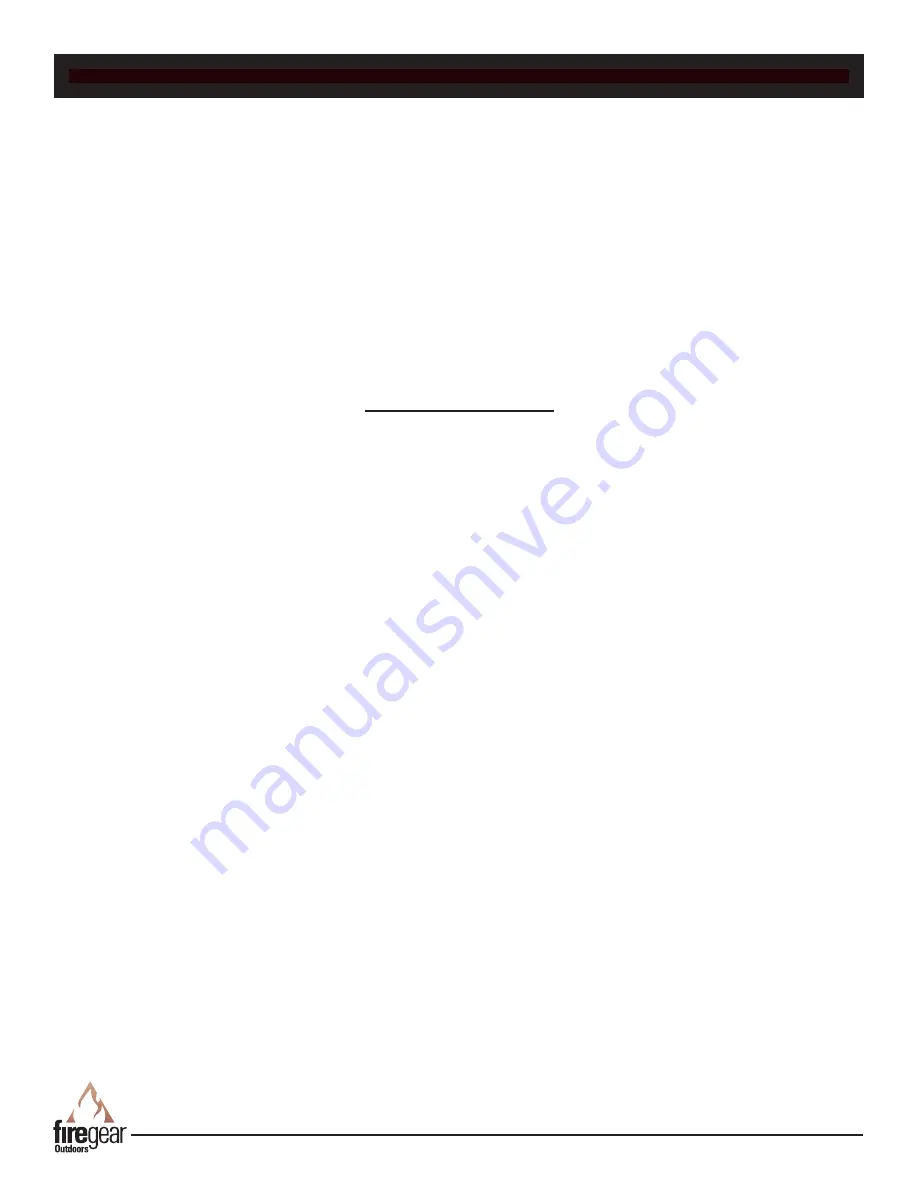
REV. 8-9-19 Page 16
AWS Sanctuary 2 & 3 Fire Features
AWS FIRE FEATURE MAINTENANCE
1.
These fire features should be inspected and cleaned before initial use at least annually by a qualified field service
person.
2. Any component that is found faulty must be replaced with an approved component.
3.
Any tampering or modifying with the fire feature is dangerous and voids all warranties.
4.
During winter months in cold climates and various seasons of operation the fire feature may be affected by weather
conditions. It is recommended to use a cover/lid overtop of your fire feature to protect it from humid/rainy weather
conditions when not in use. Heavy rains/downpours could affect the fire feature operation if not covered; if this
occurs ensure you allow the fire feature time to dry out before attempting to operate.
NOTE
: If a combustible type
cover is used over the fire feature when not in use be sure to remove it before operation to prevent a severe safety
hazard.
5. Carbon (soot) may build up on the surface of logs (if installed) during heavy use. Sooting may also occur periodically
on the screen of the ignitor hood. To clean, brush off with a dry bristle brush or cloth. Keep soot away from clothing
or furniture.
6. Over time stainless steel parts can discolor when heated, usually a golden or brown hue. This discoloration is normal
and does not affect the performance of the appliance.
GFRC MAINTENANCE
• To care for your GFRC (Glass Fiber Reinforced Concrete) product, please utilize careful judgment. It is a durable
and forgiving material, but that does not mean you can expose it to harsh chemicals or mechanical cleaning methods
which could damage the outer finish. Instead, we recommend you use a soft brush with natural or synthetic bristles,
utilizing very light pressure and water to clean the concrete items.
• Concrete by nature, is a porous material and therefore, susceptible to staining. In addition, over time it will age some-
times changing the color just as the common household driveway will. Sealing of products is always recommended
to protect the original appearance. Our products are sealed prior to shipment but the continued care and resealing of
the product will be needed every 4-5 years to protect the appearance.
• With a concrete sealant, your concrete will look great and natural for many occasions. Prolonged contact with overly
acidic, heavily pigmented or alkali substances should be avoided. We recommend cleaning any spills as quickly as
possible. Take caution against use of caustic acids to clean or resurface concrete products. Such caustic acids have
historically been used to clean pools, sidewalks or other porous concrete surfaces. These acids will etch the surface
and change the structure of the concrete at the surface level. Our concrete is made to have a denser and cleaner
look; such etching from caustic acids will change that clean, smooth finish.
• DO NOT USE HARSH ABRASIVE CLEANERS, ACIDS, PIGMENTED CLEANERS OF ALKALI SUBSTANCES ON
CONCRETE PRODUCTS.
While in some applications it MAY be safe to use muriatic acid/hydrochloric acid or sulfuric
acid, or other strong chemicals to clean concrete, DO NOT use these cleaners to clean the items we sell made from
reinforced concrete. This WILL damage the beautiful finish on the outside of the concrete. Such chemical cleaners are
not applicable for use on this type of material.
•
Additionally, we do not recommend using high-pressure cleaning, as this could remove the sealed finish. Using a
garden hose will be enough pressure to clean the concrete. For normal spills, a quick wipe up and gentle “scrub” with
a cotton cloth or similar, should be enough to clean. For stains, which contain dark colors or have been sitting for
an extended period of time, you can use a mild soap. Under extreme cleaning needs, you can use a standard mild
household chlorine bleach, available in most retail stores, diluted to a very weak mixture of about 1/4 cup bleach to 1
gallon of water. Use this mixture over the entire surface you wish to clean, to ensure even cleaning. Only do this as a
last resort as it could change the appearance of the product.
•
Please also note that fissures (hairline cracks) can appear on the surface due to age and/or exposure to the
atmospheric conditions. These commonly don’t have an effect on durability and do not compromise the structural
integrity of the product.







































